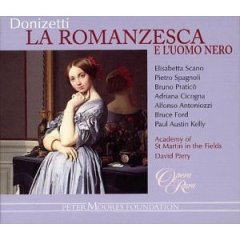Gaetano Donizetti - La Romanzesca e l'Uomo Nero (2000)
Gaetano Donizetti - La Romanzesca e l'Uomo Nero (2000)

1. Scene 1: Introduzione: Vi prego, avanti avanti
2. Scene 1: M'insulta, corbella!
3. Scene 2: Cavatina: Oh Elodia solitaria
4. Scene 3: Non v'e maggio dolore
5. Scene 3: Duetto: Ciel! Fia ver? Mio Filidoro!
6. Scene 3: Duetto: Ahi la mia nascita
7. Scene 3: Duetto: Fuggir da queste mura
8. Scene 4: Terzetto: Cinque sensi appena nato
9. Scene 4: Terzetto: L'occhietto semi-
10. Scene 5: Duetto: Che paura! Che paura!
11. Scene 5: Duetto: Ah! Ah! Ah! Ah
12. Scene 6: Terzetto: Fuggiam, fuggiam
13. Scene 6: Terzetto: Ei stresso! La mia vittima
14. Scene 6: Terzetto: Destrieri infocati
15. Scene 7: Rondo finale: Si, colpevole son io
16. Scene 7: Rondo finale: Lascio l'ombre ed I fantasmi
Il Conte - Alfonso Antoniozzi
Antonia - Elisabetta Scano
Chiarina - Adriana Cicogna
Carlino - Paul Austin Kelly
Trappolina - Elena Monti
Filidoro - Pietro Spagnoli
Tommaso - Bruno Praticó
Nicola - Alfonso Antoniozzi
Fedele - Bruce Ford
Giappone - Clive Bayley
The Academy of St. Martin in the Fields
David Parry - conductor
Once again, Opera Rara has succeeded in breathing life and vitality into one of the most obscure of Donizettiana. This one-act farsa, which originally had spoken dialogue between the musical numbers, is as delightful and rollicking as any of Donizetti's comedies. We don't know the full plot, however, because the spoken dialogue has long since been lost. This did not diminish my enjoyment of the opera at at all, however. A satire of the 19th-century obsession with romanticism, the work centers on Antonia, a spoiled girl who is disappointed with her too-normal life and wishes it were more romantic. She becomes infatuated with a "man in black" a disguised barber named Filidoro, who is willing to pander to her propensity to live in a fantasy world to further his own designs. Elisabetta Scano as Antonia is in lovely voice, handling the coloratura deftly and portraying the character of a gullible young girl very believably. As Filidoro, Pietro Spagnoli is equally delightful in his duet with Scano, as well as the rondo-finale in which both singers participate. I found myself playing these numbers over and over. There is also a delightful trio in which Tommaso, Filidoro's uncle and accomplice, gives an amusing lecture on what 'sentiment' means. Bruno Pratico, Bruce Ford, Adriana Cicogna, and Paul Austin Kelly round out a luxurious cast for such a slender work. David Parry capably conducts the Academy of St. Martin in the Fields, and keeps up a brisk and lively pace throughout. Fully 1/2 of the thickness of the jewel-box case is taken up by a copious booklet, which contains not only the obligatory synopsis and Italian-English libretto, but a scrupulous, thorough, and interesting historical account of the opera. Jeremy Commons provides a fascinating look at La Romanzesca, including the revelation that the opera's has been incorrect in every academic source since its premiere! (The opera has been traditionally called "La Romanziera"). In addition, the source play is identified for the first time in this essay. A detailed account of the work's slim performance history is also given. I am always amazed at the care and time that goes into Opera Rara's booklets. Since vinyl disappeared as a recording medium, reduced case space has forced record companies to offer only the briefest of essays (I assume this is true, anyway), and some don't even include a libretto. Opera Rara's excellent booklets are a welcome exception to this rule. The sound is better than many of Opera Rara's earlier recordings, and I didn't find myself having to turn the volume up to enjoy it. I highly recommend this sparkling little work to anyone, novice listener and bel canto aficionado alike. --- dwadefoley, amazon.com
download: uploaded anonfiles yandex 4shared solidfiles mediafire mega filecloudio
Zmieniony (Środa, 30 Październik 2013 14:52)








